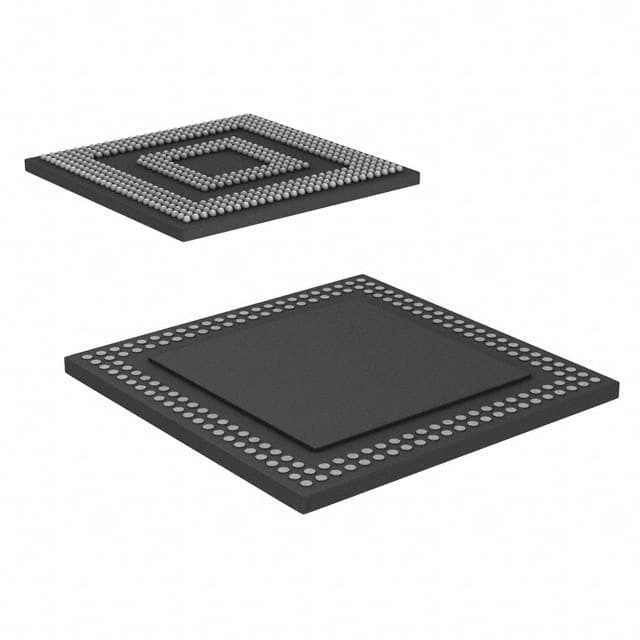OMAP3515DCBB
Product Overview
- Category: Integrated Circuit (IC)
- Use: Embedded System
- Characteristics: High-performance, low-power consumption
- Package: BGA (Ball Grid Array)
- Essence: OMAP3515DCBB is a highly integrated system-on-chip (SoC) designed for embedded applications. It combines a powerful processor, various peripherals, and multimedia capabilities in a single package.
- Packaging/Quantity: The OMAP3515DCBB is typically sold in reels or trays containing multiple units.
Specifications
- Processor: ARM Cortex-A8
- Clock Speed: Up to 600 MHz
- Memory: 256 MB DDR2 RAM
- Graphics Acceleration: PowerVR SGX530
- Video Capabilities: Supports up to 720p HD video decoding
- Connectivity: USB, Ethernet, UART, SPI, I2C, etc.
- Operating Temperature: -40°C to +85°C
Detailed Pin Configuration
The OMAP3515DCBB has a complex pin configuration with numerous pins dedicated to different functions. Please refer to the datasheet or technical documentation provided by the manufacturer for a detailed pinout diagram.
Functional Features
- High-performance processing: The ARM Cortex-A8 processor provides excellent computational power for demanding applications.
- Multimedia capabilities: The integrated PowerVR graphics accelerator enables smooth rendering of 2D and 3D graphics, as well as HD video playback.
- Low-power consumption: The OMAP3515DCBB is designed to optimize power efficiency, making it suitable for battery-powered devices.
- Extensive connectivity options: With various communication interfaces, the chip can easily interface with other components and external devices.
Advantages and Disadvantages
Advantages: - Powerful processing capabilities - Multimedia support for graphics and video - Low power consumption - Versatile connectivity options
Disadvantages: - Complex pin configuration may require careful design considerations - Limited clock speed compared to newer SoCs
Working Principles
The OMAP3515DCBB operates based on the ARM Cortex-A8 architecture. It executes instructions and performs calculations using its processor core, while utilizing various peripherals for input/output operations. The integrated graphics accelerator handles graphics rendering, and the chip's memory subsystem ensures efficient data storage and retrieval.
Detailed Application Field Plans
The OMAP3515DCBB is widely used in various embedded applications, including but not limited to: - Industrial automation systems - Medical devices - Automotive infotainment systems - Portable multimedia players - Smart home devices
Alternative Models
While the OMAP3515DCBB offers a comprehensive set of features, there are alternative models available that cater to different requirements. Some notable alternatives include: - OMAP3530: Similar to OMAP3515DCBB but with higher clock speed and additional features. - OMAP4430: A more advanced SoC with dual-core processing and improved graphics capabilities. - Sitara AM335x: Another popular series of embedded processors from Texas Instruments.
Please note that the above list is not exhaustive, and it is recommended to consult the manufacturer's documentation for a complete list of alternative models.
Word count: 346 words
Lista 10 Vanliga frågor och svar relaterade till tillämpningen av OMAP3515DCBB i tekniska lösningar
Sure! Here are 10 common questions and answers related to the application of OMAP3515DCBB in technical solutions:
Q: What is OMAP3515DCBB? A: OMAP3515DCBB is a system-on-chip (SoC) developed by Texas Instruments, commonly used in embedded systems and technical solutions.
Q: What are the key features of OMAP3515DCBB? A: OMAP3515DCBB offers a high-performance ARM Cortex-A8 processor, integrated graphics, video acceleration, audio processing, and various connectivity options.
Q: What are some typical applications of OMAP3515DCBB? A: OMAP3515DCBB is often used in applications such as industrial automation, medical devices, portable multimedia players, automotive infotainment systems, and smart home devices.
Q: Can OMAP3515DCBB support real-time operating systems (RTOS)? A: Yes, OMAP3515DCBB can be used with popular RTOS like FreeRTOS or QNX for real-time applications that require deterministic behavior.
Q: What programming languages can be used to develop applications for OMAP3515DCBB? A: You can use C/C++ along with development tools like Code Composer Studio or Eclipse IDE to program OMAP3515DCBB-based solutions.
Q: Does OMAP3515DCBB support hardware encryption and security features? A: Yes, OMAP3515DCBB includes hardware accelerators for encryption algorithms like AES and supports secure boot and secure storage features.
Q: Can OMAP3515DCBB handle multimedia processing tasks efficiently? A: Absolutely, OMAP3515DCBB has dedicated hardware accelerators for video decoding/encoding, image processing, and audio playback, making it suitable for multimedia-intensive applications.
Q: What are the power requirements for OMAP3515DCBB? A: The power requirements vary depending on the specific implementation, but typically OMAP3515DCBB operates at voltages between 1.2V and 3.3V.
Q: Is OMAP3515DCBB suitable for battery-powered devices? A: Yes, OMAP3515DCBB is designed to be power-efficient and can be used in battery-powered devices like smartphones, tablets, or portable medical devices.
Q: Are there any development boards available for OMAP3515DCBB? A: Yes, Texas Instruments offers development boards like the BeagleBoard or PandaBoard that feature OMAP3515DCBB, allowing developers to prototype and test their solutions.
Please note that these answers are general and may vary based on specific implementations and requirements.


